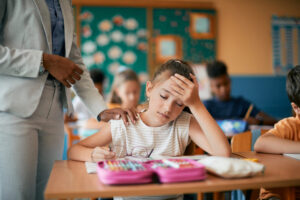Source: American Migraine Foundation
How to navigate school, friends, sports and home life when you have a child with migraine
The impact of migraine on a child’s quality of life has been well-documented. Emotional issues and school performance are among the most common problems. Kids often don’t tell others about their migraine, including teachers and other children, which may make their behavior seem confusing or anti-social. Here’s what to be alert for and how to stay involved in minimizing the negative effects of migraine in kids when it comes to your child’s quality of life:
School
In school, missed classes, poor or failing grades and truancy can all be signs that your child with migraine is struggling academically. Parents should get involved—pay attention to your kid’s grades and class attendance, and tell teachers and school nurses about your child’s migraine condition.
Parents can work with teachers, school nurses and other health-related educators to raise awareness of the academic barriers that kids with migraine face. Teachers sometimes mistake a child who is experiencing migraine as “daydreaming” or disinterested, which might lead them to misperceive the child as lazy. If they feel their child is disabled by migraine, parents should also be aware of Chronic Health Form 504, which officially prohibits discrimination against kids with disabilities.
Friends
For children with migraine, social ostracism or exclusion from peer groups is a possibility. Other kids may not seek them out socially because they think that a migraine attack may prevent them from taking part in group activities. Studies show that migraine in both children and adults is stigmatized and may result in bullying and shaming by those who don’t believe it causes real pain.
In spite of this, parents should encourage their child to be open and honest with their friends about their migraine attacks. This can often be a tall order for teenagers in particular, but will ultimately be beneficial to your child.
Sports
Some kids choose not to participate in sports or exercise because it makes their migraine attacks worse. This may make it hard for them to fit in with their peers, manage their weight or stay healthy and active.
Parents should support their child’s decision to opt out of or limit sports activities if migraine attacks are frequent or severe. If kids do wish to take part in these activities, parents should encourage children to do as much as they feel they can. It is also helpful for kids to learn to monitor the impact of their activity as a potential migraine trigger.
Home Life
At home, kids with migraine symptoms, such as sensitivity to light and sound, are often irritable and may withdraw to their room due to pain. Other issues that can stress family relationships include parents having to miss work because their child has a migraine attack, or siblings having to “chill” because their brother or sister is sick with migraine.
Family discussions and continued openness about a sibling’s migraine may encourage understanding and reduce resentment. Parents who are docked pay because of a sick child, or feel that missing work may jeopardize their job, should know they have some protection under the Family and Medical Leave Act.
It is possible for your child to live a normal life despite experiencing migraine. The American Migraine Foundation’s doctor-verified resource library has a variety of articles on pediatric migraine that can help navigate migraine in kids, and our Find a Doctor tool can help you find them a headache specialist in your area.
To read the full article about Pediatric migraines, click here.
